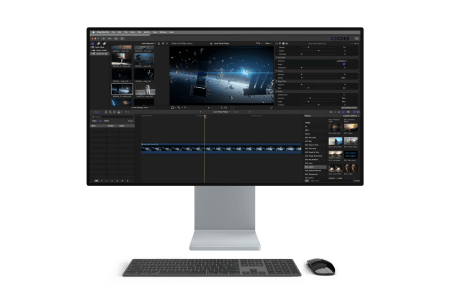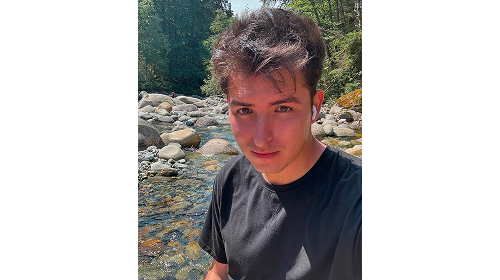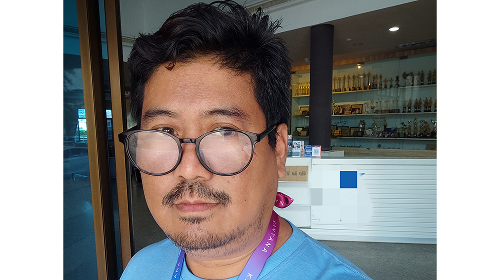

Why SynthEyes?
Professional 3D Tracking for Any Challenge
Streamlined Export and Compatibility
Expert Lens Calibration and Precise Scene Configuration
Empowering Creators with Value and Knowledge
Trusted By The Industry's Best
Behind The Scenes
Export to Your Favorite Application
Work in standalone

macOS

Windows

Linux
System requirements
Operating System
- MacOS Monterey (12) or later. Big Sur or later is required for Blackmagic RAW.
IMPORTANT
- Cheese-grater Mac Pros from 2012 and earlier won’t work. SynthEyes requires the AVX instruction set, which can be checked using the terminal command “sysctl machdep.cpu.features.” If SynthEyes crashes at startup on an older processor, the lack of AVX support is the cause. Older CPUs do not support the performance improvements enabled by AVX. SynthEyes 1905 is the last version that can run on older CPUs.
Machine Learning (ML) Plugins
- Machine Learning Plugins (ML) require an Apple silicon integrated GPU with macOS Monterey (12.0) and above. If an appropriate GPU is not available, ML plug-ins can run on the CPU with significantly degraded performance.
System Memory (RAM)
- Minimum 2 GB RAM, with 4+ GB strongly recommended. Professional, 360VR, and film users typically use 8-32 GB or more.
Graphics Processor (GPU)
- Universal build for Apple Silicon (M1/M2/etc.) or Intel Macs with AVX support (Sandy Bridge or later).

Operating System
- Windows 10 or later
IMPORTANT
- SynthEyes requires the AVX instruction set and may notify users at startup if their processor lacks support. Microsoft’s cpuinfo64 tool provides detailed CPU information. If SynthEyes crashes at startup, an unsupported processor is likely the cause. AVX is required for performance optimizations that older CPUs do not support. SynthEyes 1905 is the last version that can run on older CPUs.
Machine Learning (ML) Plugins
- Machine Learning (ML) Plugins require an NVIDIA GPU with compute capability 6.0 or above (Pascal), or an AMD Radeon™ PRO Series GPU. If an appropriate GPU is not available, ML plug-ins can run on the CPU with significantly degraded performance.
Processor (CPU)
- Intel or AMD x86_64 processor with AVX (Sandy Bridge or later, or comparable AMD). Atom-based processors are not supported.
System Memory (RAM)
- Minimum 2 GB RAM, with 4+ GB strongly recommended. Professional, 360VR, and film users typically use 8-32 GB or more.
Graphics Processor (GPU)
- 64-bit Intel version of Windows 10 or 11. Windows 10 version 1903 or later is required for full globalization support. Supports HEVC/h.265.

Operating System
- CentOS 7+ or a compatible Linux distribution on x86_64.
IMPORTANT
- SynthEyes requires the AVX instruction set and may notify users at startup if their processor does not support it. If SynthEyes crashes at startup, an older processor without AVX is likely the reason. AVX enables performance improvements that are not possible on outdated CPUs. SynthEyes 1905 is the last version that can run on older CPUs.
Machine Learning (ML) Plugins
- Machine Learning (ML) Plugins require an NVIDIA GPU with compute capability 6.0 or above (Pascal). If an appropriate GPU is not available, ML plug-ins can run on the CPU with significantly degraded performance.
Processor (CPU)
- Intel or AMD x86_64 processor with AVX (Sandy Bridge or later, or comparable AMD). Atom-based processors are not supported.
System Memory (RAM)
- Minimum 2 GB RAM, with 4+ GB strongly recommended. Professional, 360VR, and film users typically use 8-32 GB or more.
Graphics Processor (GPU)
- 1280x768 or larger display with OpenGL support. High-DPI displays supported with 100% or 200% scaling. 32-bit 8bpc RGBA format required. Large multi-head configurations require graphics cards with sufficient memory. RED GPU decode assist requires 2+ GB video RAM.

Flexible Lens Workflow Export
Applies lens distortion correction automatically at export, ensuring consistent, distortion-aware results across all platforms.ML Motion Estimation
Uses machine learning to generate accurate motion vectors, improving track quality and reducing manual cleanup.Mesh-to-Tracker Parenting
Links meshes to trackers with a click, streamlining object alignment and preserving relationships through export.Additional Enhancements
Expanded mask controls, auto video rotation, LUT folder organization, and new Blackmagic RAW 17K codec support.
Flexible Lens Workflow Export: Predictable, Consistent Lens Distortion Across Your Pipeline
The Flexible Lens Workflow Export option removes the guesswork from distortion management. It lets you apply and export undistorted or redistorted imagery per-export, preserving the original scene while giving you precise control over margins, resolution, and downstream compatibility, all without locking your project into a destructive state.
- Unified Export Behavior: Apply undistort/redistort exactly when and where needed, without permanently altering your scene.
- Non-Destructive: Keep your footage and solve untouched, distortion settings are export-specific and easily reversible.
- Consistent UI: A shared interface across all export modules ensures fast, reliable configuration for every shot.
ML Motion Estimation: AI-Assisted Tracking Precision
ML Motion Estimation brings machine learning directly into the auto-tracking process, generating dense per-pixel motion vectors to improve tracker prediction, reduce cleanup, and lower solve error - especially in challenging footage.
- Per-Pixel Motion Vectors: Analyze motion with greater spatial accuracy across frames.
- Robust in Challenging Shots: Handles occlusion, blur, flicker, and repeating textures.
- Lower hpix Values: Produces more stable, confident tracker positions.
- Seamless Integration: Activates through a new motion model in the tracking UI.
Mesh-to-Tracker Parenting: Effortless Layout That Stays Locked In
This feature lets you parent meshes directly to solve points with a click, keeping your layout synced as your solve evolves, no more constant repositioning or manual cleanup after every change.
- Click-to-Parent: Snap geometry to trackers instantly in the viewport, pivot and all.
- Persistent Across Solves: Geometry stays locked to trackers even after adjusting distortion, scale, or constraints.
- Export-Ready Hierarchy: Mesh relationships carry cleanly through exports to 3D and compositing apps.
- Editable Offset Support: Freely adjust pivot points or geometry offsets without breaking the link
Additional Enhancements: Workflow Refinements & Format Expansions
- Mask ML Mask Dilation: Expands or contracts mask edges by a set number of pixels to reduce edge tracking artifacts like blurry hair or soft fringes.
- Automatic Video Orientation Handling: Automatically rotates JPEG, PNG, TIFF, and ProRes files based on embedded orientation metadata, no manual adjustments required.
- Dedicated LUTs Folder: Introduces a default folder location for organizing LUTs (.cube, .3dl, .lut), making them easier to manage and automatically accessible in the interface.
- New Codec Support: Adds support for Blackmagic RAW SDK 4.5 to directly import URSA Cine 17K 65 footage.
Revolutionizing Object Tracking & Masking
The new Mask ML feature harnesses advanced machine learning to radically reduce manual rotoscoping. With fast, intuitive object selection, Mask ML quickly propagates precise, edge-aware masks across multiple objects and complex shapes—delivering cleaner 2D tracks and superior 3D solves. It frees artists to focus on creative tasks while ensuring optimal tracking accuracy.
- Instant Mask Creation: Click or drag to generate precise, edge-aware masks instantly.
- Rapid Multi-Object Masking: Mask several objects simultaneously to accelerate your workflow.
- Roto Panel Integration: Automatically add each mask as a separate layer for organized compositing.
- Batch Processing: Process multiple shots in the background, freeing you to focus on creative tasks.
Powerful New Export Management
Multi-Export centralizes your export process in SynthEyes, providing a single, intuitive interface to configure and run multiple exporters. Its persistent settings and flexible controls let you quickly set up complex export configurations for various applications, ensuring consistent and efficient deliverables across projects.
- Centralized Export Hub: Manage all export settings from a single interface.
- Flexible Preset Control: Save and recall tailored configurations with ease.
- Selective Export Filters: Define which objects, trackers, or meshes to include or exclude.
- Dynamic Destination Management: Standardize file naming and organization with preset tags.
- Easy Versioning: Duplicate exporters to quickly set up output variations.
A New Way of Workflow Optimization
The Workflow Presets Manager in SynthEyes 2025 replaces the old preferences system with a hierarchical preset structure that streamlines and scales your workflow. Organized across Built-in, Facility, User, and Scene levels, it lets you set up new projects quickly while preserving flexibility for advanced customization.
- Faster Project Setup: Apply comprehensive presets—from lens distortion models to exporter settings and viewports—to save time on every new project.
- Consistent, Collaborative Workflows: Standardize settings across teams or facilities while allowing scene-specific tweaks to meet diverse project needs.
- Greater Visibility & Control: Monitor and fine-tune presets, reducing errors and ensuring precise workflow management.
- Project Selector: Kick off every project with consistent, reproducible settings by capturing your current preferences into reusable presets, minimizing setup time and potential errors.
Streamlined Close-Up Head Tracking
SynthEyes 2025 also provides a pre-built, animation-ready head mesh to tackle close-up head tracking tasks when actor-specific head scans aren’t available. This versatile tool ensures:
- Quick Setup: Load the head mesh directly from the SynthEyes library to start tracking immediately.
- Time Savings: Skip custom modeling and focus on fine-tuning your facial aligns, beauty work, or digital makeup.
- Efficient Integration: Seamlessly align with SynthEyes’ advanced tracking tools for high-accuracy facial solves.
Dynamic Tagging Streamlines File Organization
SynthEyes offers a new approach to file organization through dynamic tagging. With the Project Tag Manager, you can automatically generate consistent folder paths for scenes, exports, and other assets—ensuring every new scene follows your custom blueprint. This powerful tool eliminates repetitive manual entry, simplifying setup and boosting your workflow efficiency.
- Centralized Organization: Automatically create and maintain uniform folder structures for all project assets.
- Custom Export Paths: Easily define dedicated paths for various exporters and output types.
- Streamlined Workflow: Save time by eliminating manual path entry and ensuring consistent file management
Production Grade Tracking and Solving
SynthEyes offers a comprehensive toolkit for professional camera and object tracking, combining supervised workflows with high-performance automation, flexible solve controls, and precision export support.
- Advanced tracking features, including automatic tracking, 3D planar tracking, and AprilTags, with tools for cleanup and adding trackers
- Track cameras and moving objects using geometric hierarchy tracking, with support for stereoscopic 3D workflows
- Precise 3D and 2D planar tracking with mask options and Mask ML for machine-learning-driven object isolation
- Use ML Motion Estimation to generate per-pixel motion vectors, improving auto-tracking accuracy and reducing cleanup in complex shots
- Handle multiple supervised trackers simultaneously with intuitive selection and organization tools
- Calibrate a wide range of lens types, including radial-4th and anamorphic-6th models with animated distortion parameters
- Ideal for 360° VR, motion capture, and long or complex sequences, with built-in 360° stabilization tools
- Refine camera and object paths using flexible solver settings and post-solve cleanup tools
- Align solves to 3D set models such as lidar scans for seamless integration
Scene Exports
SynthEyes provides powerful export tools to integrate your tracked scenes into 3D and compositing workflows with accuracy and control.
- Multi-Export, a centralized export hub, enabling simultaneous setup of multiple export scenarios (e.g., Nuke, Maya, Blender)
- Built-in and custom presets, allowing quick application or modification of export configurations at user, scene, or facility levels
- Object inclusion/exclusion features, providing fine control over which trackers or objects are exported to reduce file clutter
- Persistent and flexible configurations, saving entire export setups for quick reuse on future shots
- Native project data export to 3D packages, ensuring seamless transfer to Maya, 3ds Max, Blender, LightWave, and Cinema 4D without data loss
- Compositing integration, facilitating the creation of project scenes in After Effects, Nuke, Fusion/Resolve, Flame, and Houdini
- Flexible Lens Workflow Export, ensuring consistent and distortion-aware exports across all major formats
- Distortion and stabilization maps export, delivering animated stabilization and lens distortion data where supported
- Advanced pipeline capabilities, offering flexible ASCII text exporters for tracker 2D paths, 3D positions, camera/object paths, and animated illumination
Coordinate System Setup
Syntheyes offers powerful tools to position, align, and size the entire scene in a 3D environment, so you can ensure the world scale and coordinates of your scene match the rest of your workflow.
- Auto-placement tool analyzes scene structure to create a good initial coordinate system
- Quick precision setup wizard: click 3 trackers, then realign
- Easy manual re-positioning and scaling of the entire scene
- Line-based alignment system for nodal-tripod and lock-off shots, or use the mesh pinning tool in its camera setting
- Flexible coordinate system alignment controls and coordinate placement methods based on camera positioning
- Constrained points (axis control) view to quickly examine and modify coordinate system settings of all trackers
- Select solutions using coordinate polarity controls when multiple solutions are possible
- Exact and distance constraints for survey data, including infrequent GPS waypoints and on-set sizing measurements
- Coordinate system setup available before or after solving
Lens Calibration
SynthEyes has extensive tools not only for calculating distortion during solving, but also for lens calibration from lens grids. Rectify lens grid for “just fix it” unmodeled lens distortion correction, especially for complex lens types. Tilt detection and correction if grid spacing and camera-to-grid measurements are available. Lens master calibration system handles linear, inverse linear, anamorphic lenses, and four fisheye lens variants.
- Rectify lens grid for distortion correction
- Calibration for various lens types
- Calibration methods including random-dot calibration
- Lens distortion presets for different workflows
- Lens distortion presets for different workflows; easier to manage with the (NEW) Workflow Presets Manager
Geometric Hierarchy Tracking
Spectacularly powerful and flexible toolset for 3D tracking multi-level constrained hierarchies of moving parts, directly tracking supplied meshes, or using normal (supervised) trackers.
- Toolset for tracking moving parts in 3D
- Tracking of kinematic chains and secondary animation
- Integration with motion capture for BVH export
Stabilization
SynthEyes features integrated stabilization for normal and 360VR shots driven by 3D solves, including creating a "physical" rig for export.
- Stabilization capabilities are built into the image preprocessor including normal (with lens distortion) and 360VR shots
- Stabilization driven by full 3D solves, or approximate 2D tracking data
- Manual adjustments as needed
- Automatic "zoom" determination for normal shots (multiple modes)
- Stabilization rig creator for non-360VR shots creates a "physical" equivalent for the stabilization, so downstream 3D packages can perform the actual stabilization
- Export of 360VR stabilization data directly to supported packages including After Effects, Fusion, and Hitfilm
- Setup of 360VR stabilization as an animated textured sphere for alternative export
- Integrated resampling to other output resolutions and aspects
Object Separation
SynthEyes simplifies object separation by isolating moving subjects and excluding unwanted areas from tracking. By combining advanced machine-learning with traditional region tools, it ensures that only the essential elements are tracked, delivering cleaner, more accurate 3D solves and significantly reducing tedious manual rotoscoping.
- Rapid object isolation with Mask ML, which tracks moving objects and generates precise garbage mattes for faster, more accurate 3D solves
- Automatic selection of trackers within green screen regions
- Flexible region setup for moving objects or actors using either Mask ML or traditional garbage mattes
- Keyframe-animated splines, including quick square and circle spline setups, for defining tracking regions
- Importing spline control points from tracker paths for rapid region setup
- Animated enable/disable for splines
- Rotoscoped alpha-channel support for refined object separation
ViewShift System
Use ViewShift for complex object removals, combining split takes, generating animated texture maps, and more!
- Camera mapping and rendering system
- Uses matchmoved 3D camera paths and set models
- Removes objects against various reflector meshes (not just planes)
- Quick setup tools for working from a clean plate
- Illumination compensation for better matching
- Multiple timing modes
- Control via animated splines or mesh outlines
- Various output modes for previews and compositing
- Matte generation with softening
- Animated texture maps from meshes
- Multiple independent ViewShift outputs
Meshes In/Out
SynthEyes reads and writes a variety of mesh and vertex cache formats, ensuring easy exchange with major 3D and compositing applications.
- Import/export OBJ, C4D, COLLADA (DAE), DXF, PTS, LWO, XYZ Lidar, SynthEyes SBM, and more
- Vertex caches in/out: Alembic (.abc), Maya .mcx, Lightwave .mdd, 3dsmax .pc2
- Built-in Mesh Options for quick insertion into SynthEyes scenes
- Mesh-to-Tracker Parenting enables fast, accurate alignment of meshes to motion-tracked points
- Animation-Ready Head Mesh offers quick tracking for close-up head and facial shots, providing a pre-rigged foundation for digital makeup or beauty work
Scripting
Unleash next-level power through typed or spoken natural language control with Synthia, or use Sizzle or Python scripting for more traditional automation.
- Native Sizzle or Python API/SDK
- Synthia: a natural language assistant that turns plain language into script commands
- Script-based modifications and extensions to SynthEyes functionality, with direct access to scene and image preprocessing
- Enhanced script management made simpler with the Workflow Presets Manager for global or per-project settings
Workflow Presets Manager
The Workflow Presets Manager is the backbone of preset configuration, offering a robust, hierarchical framework that drives consistency and flexibility across your entire pipeline. It empowers key features like the Project Selector and Multi-Export by capturing complete project setups and automating export management, streamlining even the most complex workflows.
- Multi-Level Preset Management offers built-in, facility, user, and scene levels that cater to every pipeline scenario.
- File Templating and Shot Presets enable the creation of flexible templates and shot-level presets for streamlined workflows.
- Preset Tags standardize file naming and organization to maintain uniformity across projects and teams.
- Project Selector launches every project with reproducible settings by capturing your current preferences into reusable presets.












